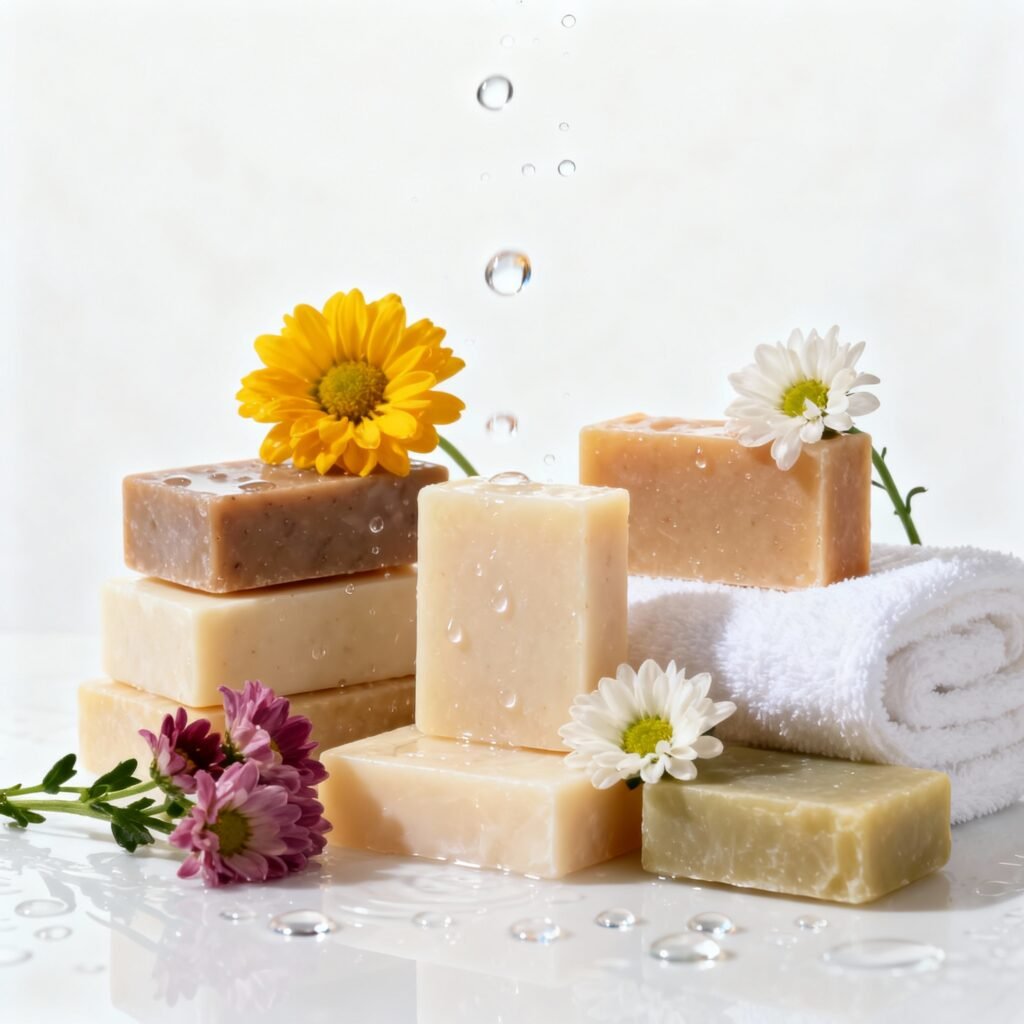When you pick up a soap bar from a store shelf, you often see a small label mentioning “TFM – 76%” or “TFM – 72%.” But have you ever wondered what this number actually means?
Well, that’s where the science of Total Fatty Matter (TFM) comes in.
TFM is the most important indicator of soap quality. It tells you how much natural fat or oil content (like coconut oil, palm oil, or tallow) is present in your soap — the very ingredients responsible for cleaning, moisturizing, and nourishing your skin.
In simple words:
🧴 Higher TFM = Better Quality Soap = Healthier, Softer Skin
⚗️ Understanding the Chemistry of Soap and TFM
To understand TFM, we first need to understand how soap is made.
Soap is produced through a chemical process called saponification — the reaction between fats or oils (which are fatty acids) and an alkali (like sodium hydroxide).
🧪 The Basic Chemical Equation:
Fat or Oil + Alkali (NaOH) → Soap + Glycerin
- The fatty acids (from oils like coconut or olive oil) are what give soap its cleansing and moisturizing properties.
- The alkali helps to form the soap structure.
- The amount of fatty material that remains in the final product is measured as TFM.
So, Total Fatty Matter (TFM) represents the percentage of pure fatty substances in soap after removing water and other non-fatty ingredients.
📊 TFM and BIS Classification (Indian Standards)
In India, the Bureau of Indian Standards (BIS) has set clear guidelines to classify soaps based on their TFM percentage.
| 🧼 Grade | 💧 TFM (%) | 🌟 Soap Quality | ✨ Effect on Skin | 🧴 Examples (Approx.) |
|---|---|---|---|---|
| Grade 1 | 76% and above | Premium quality | Rich, creamy lather, very mild | Mysore Sandal, Dove, Pears |
| Grade 2 | 70% – 75% | Good quality | Cleans well but slightly drying | Lux, Hamam, Lifebuoy |
| Grade 3 | Below 70% | Low quality | Harsh, drying, more alkaline | Local brands, detergent bars |
According to BIS, any toilet soap should ideally have TFM above 70%, while laundry or industrial soaps can have lower values.
💧 How TFM Affects Soap Quality
The TFM value determines everything about your soap — from how it feels on the skin to how well it lathers and cleans.
Let’s understand how:
| Parameter | High TFM (76%+) Soap | Low TFM (<70%) Soap |
|---|---|---|
| Lather Quality | Rich and creamy | Flat and bubbly |
| Skin Feel | Soft, moisturized | Dry and rough |
| Cleansing Power | Gentle yet effective | Harsh and irritating |
| Fragrance Retention | Longer lasting | Fades quickly |
| pH Level | Balanced, skin-friendly | Higher, more alkaline |
| Shelf Life | Longer, more stable | Shorter, prone to cracking |
🌿 The Science Behind Fatty Matter
Natural oils used in soap making contain fatty acids such as:
| Oil Type | Main Fatty Acids | Benefit |
|---|---|---|
| Coconut Oil | Lauric & Myristic | Good cleansing, creamy foam |
| Olive Oil | Oleic Acid | Gentle, moisturizing |
| Palm Oil | Palmitic & Stearic | Hardness, smooth lather |
| Castor Oil | Ricinoleic | Softens and nourishes skin |
| Tallow (Animal Fat) | Stearic & Palmitic | Firm texture, dense foam |
Soaps rich in these fatty acids naturally have a higher TFM, which improves skin texture and hydration.
💆♀️ Benefits of High TFM Soap
Let’s explore why high TFM soaps are considered superior 👇
- 🌸 Gentle on Skin:
High TFM soaps contain more natural oils, making them mild and less alkaline — perfect for daily use. - 💦 Moisturizing Effect:
They retain skin’s natural oils and prevent dryness or itchiness. - 🧴 Better Lathering:
Creamy and stable foam makes them pleasant to use and easy to rinse. - 🌿 Natural Ingredients:
Premium soaps with high TFM often use essential oils and herbal extracts. - 🌞 Long-lasting Bars:
Due to their dense structure, high TFM soaps melt slowly and last longer.
⚠️ Drawbacks of Low TFM Soaps
Not all soaps are created equal!
Many cheap soaps have low TFM, meaning they contain fillers, detergents, or synthetic agents.
Here’s what happens when you use low TFM soaps:
- ❌ Makes skin feel tight or dry after use
- ❌ May cause irritation or itching
- ❌ Produces harsh, less creamy foam
- ❌ Often removes too much natural oil
- ❌ Not suitable for sensitive or baby skin
👶 TFM Recommendations for Different Skin Types
| Skin Type | Ideal TFM Range | Recommended Soap Type |
|---|---|---|
| Dry Skin | 76% and above | Creamy moisturizing soap (e.g., Dove, Mysore Sandal) |
| Oily Skin | 70–75% | Refreshing and deep-cleansing soaps |
| Normal Skin | 72–76% | Balanced soaps like Lux or Pears |
| Sensitive Skin | 78%+ | Herbal or baby soaps |
| Combination Skin | 70–76% | Mild, balanced soaps |
🧪 How is TFM Measured?
In laboratories, TFM is calculated through a chemical process involving acid digestion and titration.
The soap sample is broken down to extract fatty substances, which are then weighed to determine the percentage of fatty matter present.
The formula used is roughly:
TFM (%) = (Weight of Fatty Matter / Weight of Soap Sample) × 100
This helps ensure that manufacturers maintain consistent quality in every batch.
💬 TFM vs Non-TFM Soaps (Detergent Bars)
There’s a big difference between soap and detergent bars, though many people confuse the two.
| Feature | High TFM Soap | Detergent Bar (Low TFM) |
|---|---|---|
| Main Ingredient | Natural oils/fats | Synthetic surfactants |
| Skin Feel | Soft and smooth | Harsh and drying |
| Lather Type | Creamy and natural | Foamy but harsh |
| Skin Safety | Gentle | Can cause irritation |
| Purpose | Personal use | Laundry or cleaning |
So next time, if your soap feels harsh — check the label! It might not be real soap at all.
🧴 BIS Standards for Toilet Soaps
According to BIS IS 2888:2004, soaps are classified into three grades.
Let’s look at the specific requirements:
| Grade | TFM Minimum (%) | Matter Insoluble in Alcohol (%) | Free Alkali (%) |
|---|---|---|---|
| Grade 1 | 76 | 2 | 0.05 |
| Grade 2 | 70 | 2 | 0.10 |
| Grade 3 | 60 | 3 | 0.20 |
These parameters ensure soaps are safe, skin-friendly, and durable.
🧴 Common Myths About TFM
❌ Myth 1: High TFM soaps always cost more.
✅ Fact: Some affordable brands also maintain good TFM values — price doesn’t always mean quality.
❌ Myth 2: All “moisturizing soaps” are high in TFM.
✅ Fact: Many “beauty soaps” add synthetic moisturizers to mask low TFM. Always check the label!
❌ Myth 3: High lather means high TFM.
✅ Fact: Lather depends on oil type and formulation, not just TFM.
🌼 Natural Oils and TFM in Herbal Soaps
Many herbal or Ayurvedic soaps use natural oils like neem, turmeric, sandalwood, or aloe vera, which enhance the skin benefits.
These natural ingredients, combined with high TFM, provide:
- Deep cleansing without dryness
- Antibacterial protection
- Natural glow
- Moisture retention
Popular herbal soaps like Mysore Sandal or Medimix maintain TFM above 76%, ensuring both purity and performance.
💧 Importance of pH and Moisture in Soap Quality
TFM isn’t the only factor — pH and moisture content also play roles.
- A neutral or mild pH (7–9) is ideal for skin.
- High moisture can make soap soft or sticky.
- High TFM soaps balance both — they’re firm but gentle.
🌿 How to Check TFM Before Buying Soap
- 🏷️ Read the Label: Most quality brands mention TFM percentage.
- 👃 Check the Fragrance: Strong chemical smell often indicates low TFM.
- 🧴 Feel the Soap: Smooth, dense, and creamy texture indicates higher fatty content.
- 🧼 Observe the Lather: Thick, rich lather is a sign of high-quality soap.
- 🌸 After-use Feel: If your skin feels tight or dry, the TFM might be low.
💡 Consumer Awareness: Why TFM Matters
The concept of TFM isn’t just for manufacturers — it’s for consumers too.
Understanding TFM helps you:
- Choose better-quality soaps
- Avoid skin irritation and dryness
- Protect sensitive skin types
- Get better value for money
The BIS grading system ensures that customers are not misled by fancy marketing, but rather make decisions based on scientific quality measures.
🌺 TFM in Baby Soaps and Medicated Soaps
Baby soaps and medicated soaps have specific formulations with high TFM (78%+) and low alkali to ensure gentle cleansing.
| Soap Type | TFM Range (%) | Purpose |
|---|---|---|
| Baby Soap | 78–80% | Extremely mild, non-irritating |
| Medicated Soap | 70–75% | Treats acne, rashes, or infections |
| Beauty Soap | 76%+ | Softens and hydrates skin |
🌞 Environmental Impact of High vs Low TFM Soaps
High TFM soaps are usually made from natural oils, which are biodegradable and eco-friendly.
Low TFM soaps or synthetic bars often contain petroleum derivatives that are less biodegradable and harmful to aquatic life.
Choosing high TFM soaps means not only caring for your skin but also protecting the planet 🌍💚.
🧴 Global Standards vs Indian TFM Standards
While India uses the TFM-based BIS system, other countries use different quality measures:
| Country | Soap Standard | Quality Parameter |
|---|---|---|
| India | BIS IS 2888 | TFM (%) |
| USA | FDA Guidelines | Ingredient declaration |
| UK | EU Cosmetic Regulation | Fatty acid labeling |
| Japan | JIS Standard | Skin pH and purity |
| France | Cosmetic Regulation 1223/2009 | Natural oil content |
India remains one of the few countries that scientifically grades soaps by fatty matter percentage.
🧴 Conclusion: Choose Wisely, Choose High TFM
In conclusion, TFM (Total Fatty Matter) is the single most important factor in determining soap quality.
A higher TFM means your soap has more natural oils, better cleansing ability, and softer after-use feel.
✅ Always choose Grade 1 soaps (TFM 76% or above) for the best results.
✅ Avoid cheap, detergent-like bars with low TFM — they harm your skin in the long run.
🌸 Remember: A good soap should clean your skin, not strip it.
The secret lies in three letters — TFM.
❓ Frequently Asked Questions (FAQs)
Q1. What is TFM in simple terms?
👉 TFM stands for Total Fatty Matter — the percentage of natural oils or fats in a soap that make it moisturizing and skin-friendly.
Q2. Which soap has the highest TFM in India?
👉 Mysore Sandal Soap and Dove are among the highest, both with TFM above 76%.
Q3. Is TFM written on every soap?
👉 It should be, as per BIS standards, but not all manufacturers follow it strictly.
Q4. What happens if I use low TFM soap?
👉 It can cause dryness, roughness, and irritation, especially for people with sensitive skin.
Q5. How can I identify high TFM soap without reading labels?
👉 High TFM soaps feel smooth, dense, and create rich, creamy foam that leaves skin soft.
Q6. Can high TFM soaps be used daily?
👉 Absolutely! They’re ideal for regular use since they nourish and protect skin naturally.






